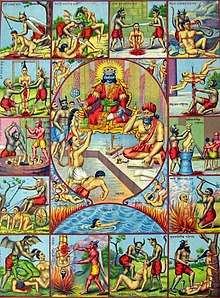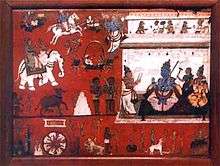Chitragupta
Chitragupta (Sanskrit: चित्रगुप्त, 'rich in secrets' or 'hidden picture') is a Hindu god assigned with the task of keeping complete records of actions of human beings on the earth and punish or reward them according to their Karmas. He is god of justice therefore known as Dharmaraja. Upon their death, Chitragupta has the task of deciding heaven or the hell for the humans, depending on their actions on the earth. Chitragupta Maharaj is the seventeenth Manasputra of Lord Brahma. Chitragupta is believed to be created from Bramha's soul & mind (chitt) and thus, alloted the right to write Vedas like Brahmins with the duty of a Kshatriya.[1]He accompanies Yamraj, the god of death.[2]
| Maharaja Chitragupta | |
|---|---|
.jpg) Chitragupta in Bangkok City Pillar Shrine Thailand. | |
| Devanagari | चित्रगुप्त |
| Sanskrit transliteration | Citragupta |
| Affiliation | Deva, Dharmaraja |
| Mantra | ॐ श्री चित्रगुप्ताय नमः
(Oṃ shri chitraguptaay Namaḥ) |
| Weapon | lekhani (Pen), Katani (Ink) and Katar (sword) |
| Personal information | |
| Parents | Brahma (father) Saraswati (mother) |
| Siblings | Four Kumaras, Narada, Daksha |
| Consort | Nandini and Shobhavati |
In scriptures
- According to the Vedic scriptures, the souls of men after death receive rewards and punishments according to their sins and virtues, and hence it is believed that good and bad deeds of men are not destroyed. The souls of men after death go to Yamapuri, which is presided over by the deities called Yamas who keep records of men's actions and accordingly give them their dues. The principal Yama is called Yamaraja or Dharamaraja, that is, the ruler of Yamapuri or the king of laws.

- The Yama Samhita, an extract from the 9th chapter of Ahilya Kamdhenu, a work of Hindu Law, says that Dharamaraja complained to Brahma about his difficulties in performing his most responsible duties of keeping records of the deeds of men and doing justice to them. Brahma went into meditation. Chitragupta sprang from his body and stood before him bearing an inkpot and a pen. The god Brahma (creator) said: "Because you are sprung from my body (kaya), therefore you shall be called Kayastha and as you existed in my body unseen I give you the name of Chitragupta. Let the Kshatriya dharma be followed by you and your progeny." He then assumed charge of Yamapuri. Dharmaraja married his daughter Irawati to Chitragupta and Sraddhadeva Manu(Manu), son of Surya (the Sun) married his daughter Sudakhina(some people say dakshina or nandini) to him." Chitragupta had eight sons from the former and four from the latter and these twelve sons became the progenitors of the twelve subdivisions of the Chitraguptavansi Kayasthas, namely Saxena, Mathur, Gaur, Nigam, Ashthana, Kulshrestha, Suryadwaja, Bhatnagar, Ambastha, Shrivastava, Karna and Vaalmik.
- Padma Purana after stating the legend says: "Chitragupta was placed near Dharamaraj to register the good and evil actions of all sentient beings, that he was possessed of supernatural wisdom and became the partaker of sacrifices offered to the gods and fire. It is for this reason that the twice-born always give him oblations from their food. As he sprang from the body of Lord Brahma he was called Kayastha of numerous gotras on the face of the earth."
- Bhavishya Purana states that God, the Creator, gave the name and duties of Chitragupta as follows: Because you have sprung from my body, therefore, you shall be called Kayastha and shall be famous in the world by the name of Chitragupta. Oh my son, let your residence be always in the region of the God of justice for the purpose of determining the merits and demerits of men.
- Vignana Tantra says the same thing.
- The same is the enjoinment of Brahma to Chitragupta according to Brihat Brahma Khanda. He was named Kayastha having sprung from the body (kaya) of Brahma. He was directed to perform all sanskars and to have writing as his profession.
- Garuda Purana describes the imperial throne of Chitragupta in Yamapuri holding his Court and dispensing justice according to the deeds of men and maintaining their record, in the following words: (There Dharmaraja, Chitragupta, Sravana and others see all sins and virtues remaining concealed in the bodies of men).
- The Mahabharata (Anusasan Parva, chapter 130) recites the teaching of Chitragupta requiring men to do virtuous and charitable acts and performing Yagya, saying that men are rewarded or punished according to their good or bad deeds.
Legends
Chitragupta came into being after Brahma, the creator, having established the four varnas — Brahmin (The Learned), Kshatriya (The Warriors), Vaishya (Merchant) and Shudra (Labourer or Farmer) — ordained Dharamraj (also called Yamraj, the god of death) to keep record of the deeds — good and evil — of all life-forms born and yet to be born on earth, in the heavens above and in the lands below. Dharamraj, however, complained, "O Lord, how can I alone keep record of the deeds of the beings born into 84 lakh yonis (life-forms) in the three worlds"
Brahma went into meditation for 11,000 years and when he opened his eyes he saw a man holding pen and ink-pot in his hands and a sword girdled to his waist. Brahma spoke:
Thou hast been created from my body (Kaya), therefore shall thy progeny be known as the Kayasthas. Thou hast been conceived in my mind (Chitta or Chitra) and in secrecy (gupta), thy name shall also be Chitragupta. Let the role of a Kshatriya be followed by thee and thy progeny.
Brahma then enjoined him to dispense justice and punish those who violated the dharma.
In the Garuda Purana, Chitragupta is hailed as the "giver of letters" (Chitragupta namastubhyam vedaksaradatre).
In the legends of Chitragupta as well as in the Vedas, he is referred to as the greatest king, while the rest are "Rajakas," or little kings.
चित्र इद राजा राजका इदन्यके यके सरस्वतीमनु।
पर्जन्य इव ततनद धि वर्ष्ट्या सहस्रमयुता ददत॥ RIG VEDA Book 8/ Hymn 21/ Stanza 18
[3]
The Rig Veda mentions an invocation to be made to Chitragupta before offering sacrifice. There is also a special invocation to Chitragupta as Dharmraj (Lord of Justice) to be made at the performance of shradh or other rituals. "Om tat purushaya vidmahe Chitragupta dhimahi tena lekha prachodayata."
Chitragupta is the Athi Devathai for Ketu, one of the Navagrahas, and those who worship Chitragupta, would be bestowed with prosperity. Also the evil effects of Ketu during its transit period would be mitigated.
Temples
There are numerous temples dedicated to Chitragupta. Notable examples include:
- Chitragupta temple, Khajuraho, Madhya Pradesh
- Chitragupta temple, Kanchipuram, Tamil Nadu - the oldest temple in South India dedicated to Chitragupta. Archaeologist have confirmed based on the inscriptions that the temple was built during the 9th century by the Medieval Cholas.[4][5]
In popular culture
- Yam Hain Hum Hindi TV Series SAB TV
- Dharmakshetra Hindi TV series EPIC CHANNEL
References
- Gupte, TV. "Appendix I.(page 7)". TV Gupte’s translation of 1779 AD letter of Banaras Pandits to Peshwa Darbar. p. 8.
"Kayasthas are said to be of three sorts (kinds)— (1) the Chitragupta Kayasthas (2) Dhalbhaga Gatri Kshatriya Kayasthas and (3) Kayasthas of the mixed blood. The origin of Chitraguptavanshi Kayasthas is given in the Puranas. He was born from the body of Brahma while he was contemplating how he should know the good and evil acts of living beings. He was a brilliant person with pen and ink in his hands. He was known as Chitragupta and was placed near the God of death. He was appointed to record the good and evil acts of men. He was a Brahmin possessed of supra sensible knowledge. He was a god sharing the offerings at sacrifices. All the Brahmins offer him oblations of rice before taking their meals. He is called Kayastha because of his origin from the body of Brahma. Many descendants of his bearing different Gotras still exist on this earth. From this it will be seen that Kayastha Brahmins of Karhada and Khandesha are the Brahma-Kayasthas. Now about the origin of Chandraseniya Kshatriya Kayastha
- https://detechter.com/lord-chitragupta-who-helps-lord-yamaraj-to-maintain-karmic-accounts/
- https://books.google.co.in/books?id=fHYnGde4BS4C&pg=PA68. Missing or empty
|title=(help) - "Shrine for Chitragupta". The Hindu. 18 April 2003. Retrieved 2012-06-12.
- Harshananda, Swami (2012). Hindu Pilgrimage Centres (second ed.). Bangalore: Ramakrishna Math. p. 61. ISBN 81-7907-053-0.



